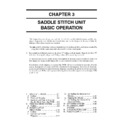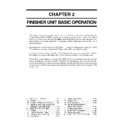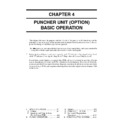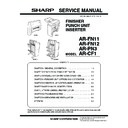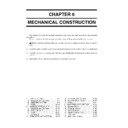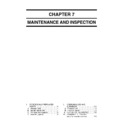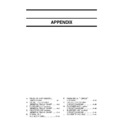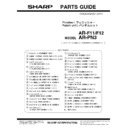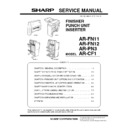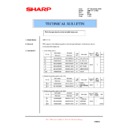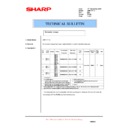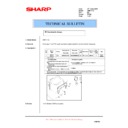Sharp AR-F12 (serv.man4) Service Manual ▷ View online
3-40
CHAPTER 3 SADDLE STITCH UNIT BASIC OPERATION
b.
B4 Stack
(PI18S)
(PI19S)
(PI18S)
(PI19S)
No.1 paper sensor
No.1 paper sensor
No.2 paper sensor
No.2 paper sensor
Feed motor
Feed motor
T: feeding of (paper length x 1.5) mm
T: feeding of (paper length x 1.5) mm
Normal
Normal
Jam
Jam
Load stops
Note: The diagram shows two sensors
checking for jams. Single detection,
however, uses only one sensor.
however, uses only one sensor.
Figure 3-604
c.
A4-R/LT-R Stack
(PI18S)
(PI19S)
(PI20S)
(PI18S)
(PI19S)
Note: The diagram shows three sensors checking
for jams. Single detection, however, uses
only one sensor.
only one sensor.
No.1 paper sensor
No.1 paper sensor
No.2 paper sensor
No.3 paper sensor
(PI20S)
No.3 paper sensor
No.2 paper sensor
Feed motor
Feed motor
Jam
Jam
Jam
T: feeding of (paper length x 1.5) mm
T: feeding of (paper length x 1.5) mm
Load stops
Normal
Normal
Normal
Figure 3-605
3-41
CHAPTER 3 SADDLE STITCH UNIT BASIC OPERATION
4.
Delivery Delay Jam
a.
By delivery sensor
The delivery sensor (PI11S) does not turn ON within a specific period of time after the paper
pushing plate top position sensor has turned ON.
Paper pushing plate top
position sensor
position sensor
Paper pushing plate top
position sensor
position sensor
Delivery sensor
Delivery sensor
Paper folding motor
Paper folding motor
T: Equivalent of 180 mm
T: Equivalent of 180 mm
Load stops
Normal
Jam
Figure 3-606
5.
Delivery Stationary Jam
a.
By vertical path paper sensor
The vertical path paper sensor (PI17S) does not turn OFF within a specific period of time (feed-
ing) after the delivery sensor (PI11S) has turned ON, i.e., the trailing edge of the stack does not leave
the vertical path paper sensor.
the vertical path paper sensor.
(PI17S)
Vertical path paper
sensor
sensor
(PI17S)
Vertical path paper
sensor
sensor
Normal
Jam
Delivery sensor
Delivery sensor
Paper folding motor
Paper folding motor
T: Feeding of
Paper length
-130
+ 50 mm
T: Feeding of
Paper length
-130
+ 50 mm
Note: The length 130 mm is the length of the feeding
path from the vertical path paper sensor to the
delivery paper sensor, while the length 50 mm
is a margin.
delivery paper sensor, while the length 50 mm
is a margin.
Figure 3-607
3-42
CHAPTER 3 SADDLE STITCH UNIT BASIC OPERATION
b.
By delivery sensor
The delivery sensor (PI11S) does not turn OFF within a specific period of time (feeding) after it
has turned ON.
Delivery sensor
Delivery sensor
Normal
Jam
Load stops
Paper folding motor
Paper folding motor
T: Feeding of
Paper length
×
1.5
mm
T: Feeding of
Paper length
×
1.5
mm
Figure 3-608
6.
Power-ON Jam
Any of the No.1 paper sensor (PI18S), No.2 paper sensor (PI19S), No.3 paper sensor (PI20S),
Vertical path paper sensor (PI17S) or delivery sensor (PI11S) on the paper sensor PCB detects paper
at power-ON.
at power-ON.
7.
Door Open Jam
The front door open/closed sensor (PI2S), outlet cover sensor (PI3S), or inlet cover sensor (PI9S)
finds that the respective cover is open during operation.
8.
Stitcher Staple Jam
When the stitcher motor (M7S/M6S) is rotating clockwise, the stitcher home position sensor
(MS7S/MS5S) does not turn ON within 0.5 secs after it has turned OFF. In addition, the sensor turns
ON within 0.5 secs after the motor has been rotated counterclockwise.
ON within 0.5 secs after the motor has been rotated counterclockwise.
9.
Saddle Feeding Delay Jam (by the paper sensor for the paper positioning plate)
The paper sensor for the paper positioning plate is not turned ON at the start of the push (folding)
operation.
Reference:
When all doors are closed after the user has removed the jam, the saddle stitch unit checks
whether the vertical path paper sensor (PI17S) has detected the presence of paper. If the sensor
has detected paper, the unit will identify the condition as being faulty jam removal and send the
jam signal to the host machine once again.
whether the vertical path paper sensor (PI17S) has detected the presence of paper. If the sensor
has detected paper, the unit will identify the condition as being faulty jam removal and send the
jam signal to the host machine once again.
3-43
CHAPTER 3 SADDLE STITCH UNIT BASIC OPERATION
VII.POWER SUPPLY
1.
Outline
When the host machine power switch is turned ON, 24V and 5V power lines are supplied by the
finisher controller PCB.
The 24V power is used to drive solenoids. The 24V power from the finisher controller PCB to
solenoids does not pass through any protective mechanisms (microswitches, or the like).
The 24V power to motors, on the other hand, will not be supplied if any of the three door
switches is open.
The 5V power is used to drive sensors and ICs.
J19-1
J3-2
J1-1
J2-5
Finisher
controller
PCB
controller
PCB
Circuit
breaker
breaker
Saddle stitch
controller PCB
controller PCB
Inlet door
switch
Front door
switch
Delivery
door switch
Solenoids
Sensors
Logic
Figure 3-701
2.
Protective Mechanisms
The 24 VDC power supply used for motors and solenoids is equipped with a circuit breaker
(CB1). The 24V power supply used to drive the feed motor (M1S), alignment motor (M5S), and the
paper positioning plate motor (M4S) is equipped with a fuse designed to blow when an overcurrent
flows.
paper positioning plate motor (M4S) is equipped with a fuse designed to blow when an overcurrent
flows.

